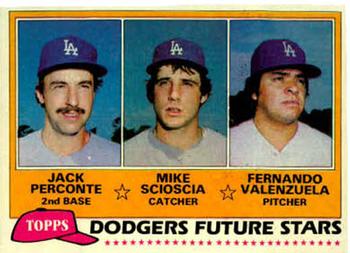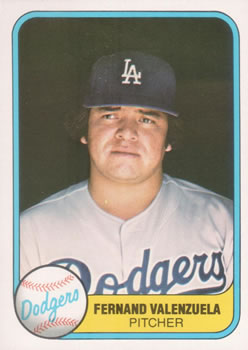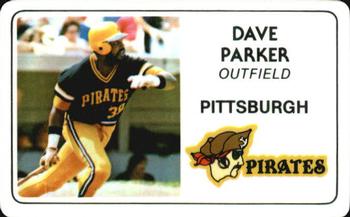This is the first in a series of Collector Time Machine posts. For those of you who weren’t collecting yet, my goal here is to give you a brief glimpse of what it was like to be a collector back then. And for those of you who lived it, here is a healthy dose of nostalgia.
The first stop of the Collector Time Machine is 1981, a year that figured prominently in the history of the hobby. It was during this year that three absolutely seismic shifts occurred–
- A rookie card took center stage.
- Other companies besides Topps joined the party.
- The Junk Wax era was upon us.
Additionally, 1981 marked the first of many seasons to follow in which Topps issued a Traded/Update set. I don’t consider this a seismic shift along the lines of the other three, and it may well be a logical consequence of the first shift already noted.
Preseason
Entering the 1981 season, there was already a notion of Rookie Card, but the RC just wasn’t that big a deal. I remember some lunchtime trades where the 1975 Fred Lynn RC and 1977 Dale Murphy RC, both multiplayer cards, were a bit more interesting than some of the other cards in the trade piles, but there was no “must have” status attached to either. A classmate had the 1971 Steve Garvey RC, which we didn’t even know definitively (or care) was an RC since it had no on-card indicator and none of us had 1970 checklists. The rest of us wanted the card, but it was more because it was an old card of Steve Garvey than because it was the likely RC.
New stuff
When the new packs came out–and there were three brands all of a sudden–Garvey was also the most sought after pull. Aside from the great Dodger first baseman and King of L.A., we wanted George Brett, Reggie Jackson, Pete Rose, Rod Carew, Johnny Bench, Yaz, and other established superstars. Though a Dodger, we more or less shrugged at reigning NL ROY Steve Howe, and only those of us who studied the stats on the back or read Baseball Digest tended to put AL ROY “Super Joe Charboneau” in our “good piles,” whether shoeboxes or pockets.
Fernandomania
And then came Fernando. Or Fernand, depending on your brand of choice!


I’ve heard other collectors from other places tell different stories, but at least in Los Angeles the Rookie Card era began with Fernandomania. As Fernando continued to rack up wins and shutouts, kids (who made up the bulk of collectors back then) just had to have his card. Even here, it wasn’t so much that we needed the rookie. It was just that we HAD to have a Fernando, and of course his RCs were the only Fernando cards to be had.
I was covered on Fleer, having ordered the factory set, and I bought so many 1981 Topps packs that year that I was probably the main supplier of Topps Fernandos to the rest of Brentwood Unified Science Magnet. It took a decent amount of buying Donruss to figure out there was no Fernando card for that brand.
I went to one of my first card shows that year and sure enough Fernando was hot there too. Dealers featured his cardboard front and center with a going rate of about $2. To this point it had been unheard of that a card straight from a pack–and of a rookie no less–could command such a price tag. To give an idea of just how nuts this was, I paid $2 at the same show for a 1961 Topps Sandy Koufax. So yes, this was big money back then.
Other RCs
Other key 1981 RCs we can recognize in hindsight are Tim Raines, Harold Baines, and Kirk Gibson. Even as Raines was stealing bases at a record-setting pace and Gibson elicited some comparisons to Mickey Mantle, these cards were nothing compared to Fernando. They weren’t on my trading or shopping radar, but I suspect they would have been priced in the $0.10-0.25 range at best. Certainly none could have been traded for a Garvey, Reggie, or George Brett card.
Error Cards

Of course, Fernando was only half the rage at the show. The other was “C” Nettles. Fleer’s first major hobby release since 1963 included dozens of errors and variations. Of all these errors, the rarest and most in demand was the Nettles card. In the first printing his first name, Graig, was spelled correctly on the front but was misspelled as Craig on the back. While other Fleer errors made it into the second printing or beyond, this was corrected right away, meaning first printing packs were the only way to rip this card.
I went to the show not even knowing about this card, but as soon as I learned about it I knew I just had to have it. Picking it up loose was not an option as the going rate seemed to be about $30, which was more than I had. What I did have left in my pocket was $12 when I found a dealer selling first printing wax for “only” $1.50 a pack. Again, this may not sound like much given what packs cost today, but I can’t even describe how nuts it was in 1981.
I bought a pack. Nothing. And that itself was something new in the hobby, though common today: buying packs in hopes of a single card and treating everything else as garbage. Don’t get me wrong, pulling a Reggie or Tom Seaver was better than nothing, but when you just paid a goddamn dollar and a half for the pack anything less than a Nettles was failure.
I bought another. Still nothing. And another. And another. And you get the idea. Nothing, nothing, nothing. Down to my last $1.50 I grabbed one more pack. By now a crowd had gathered to see this kid-gambler who was practically spending his life savings in search of “C” Nettles. I opened the pack and fainted–literally fainted.
The next thing I knew I was sitting on the floor, my brown paper bag of cards next to me and a couple adults holding me sturdy and asking if I was okay. It took me a bit to remember where I was and then panic set in. Where was my Nettles? Was it okay? What happened? Was I okay? (And yes, I really did worry about my card more than myself.)
Pulling that Nettles was a REALLY big deal. My body was physically unable to handle it. That’s how big it was. Nowadays it’s not so big a deal.

What else was HOT?
Fernando and Nettles aside, the other hot cards at the show were a baseball credit card set from Permagraphics. Though I didn’t pick up any, this was my first encounter with a premium set of cards not available through my local 7-Eleven or a cereal box. A friend of mine got the entire set for Christmas, and it was near impossible to trade for a single one. We were young kids then, and I think we treated these things as if they really were working credit cards, which most of America saw back then (and maybe still now) as free money. Hard to trade even a Fernando for that!

You might wonder if Ryan was hot yet. He was a definite superstar but not yet in a league of his own. It just came down to taste whether you’d trade a Ryan for Bench, Morgan, Reggie, or any other top star.
And what was NOT?
I’ve only barely mentioned Donruss as it was definitely the caboose on the 1981 major release train. There was no Fernand/Fernando or C Nettles, just a bunch of paper thin flimsy cards and dozens of errors/variations that failed to excite anyone. It was a set to collect just to have all three, but I don’t think anyone would have missed it had it never come out. Perhaps its most redeeming feature was its multiple cards of various superstars.
Older Stuff
Even though most of my money ended up going to Nettles, the main reason I’d gone to the show was for older cards. At that time, card shows were the only avenue I had for picking up cards of the all-time greats like Hank Aaron and Willie Mays. I fortunately scooped up that Koufax before binging on Fleer, but other than that I left empty-handed.
Still, I remember a few things about the market at that time. The 1952 Mantle was already king. A $6000 price tag comes to mind as the highest I saw at the show. I don’t recall the lowest. Other years of Mantle were priced around $15-30 in the lower grades, with Aaron and Mays about half that. Pretty decent 1960s cards of next-level superstars like Ernie Banks, Frank Robinson, and Harmon Killebrew could be had for $2-5. I was only a window shopper for the truly old stuff. I think the going rate for the Bambino was around $200, and tip top T206 HOFers (excluding Wagner) were around $100.
This was my second card show ever. The first was in 1980. I can honestly say the 1980 show seemed to give zero billing to the 1980 Topps set or any other 1980 products. The whole point of the show was vintage. Meanwhile, the buzz in 1981 was all about Fernando and Fleer. As the 1981 season wound to a close I don’t think any collector would have guessed that every card show from that point forward would center around modern. I imagine most of the dealers and collectors would have written off 1981 as a one-time phenomenon caused by the uniqueness of Fernandomania and the unusually error-ridden Fleer set.
In the next installment of the Collector Time Machine I’ll take you to 1982 and what was very definitely the (first) Year of Ripken. Stay tuned.



I really enjoyed this! I didn’t begin collecting until 1987, at the age of 8, so reading about 1981 from a kid’s point of view brought back memories. Thank you for that!
LikeLiked by 1 person
Thanks. It’s a funny thing how so many of the biggest cards when I was a kid are pretty much afterthoughts today. 1982 will be one of the few exceptions.
LikeLike